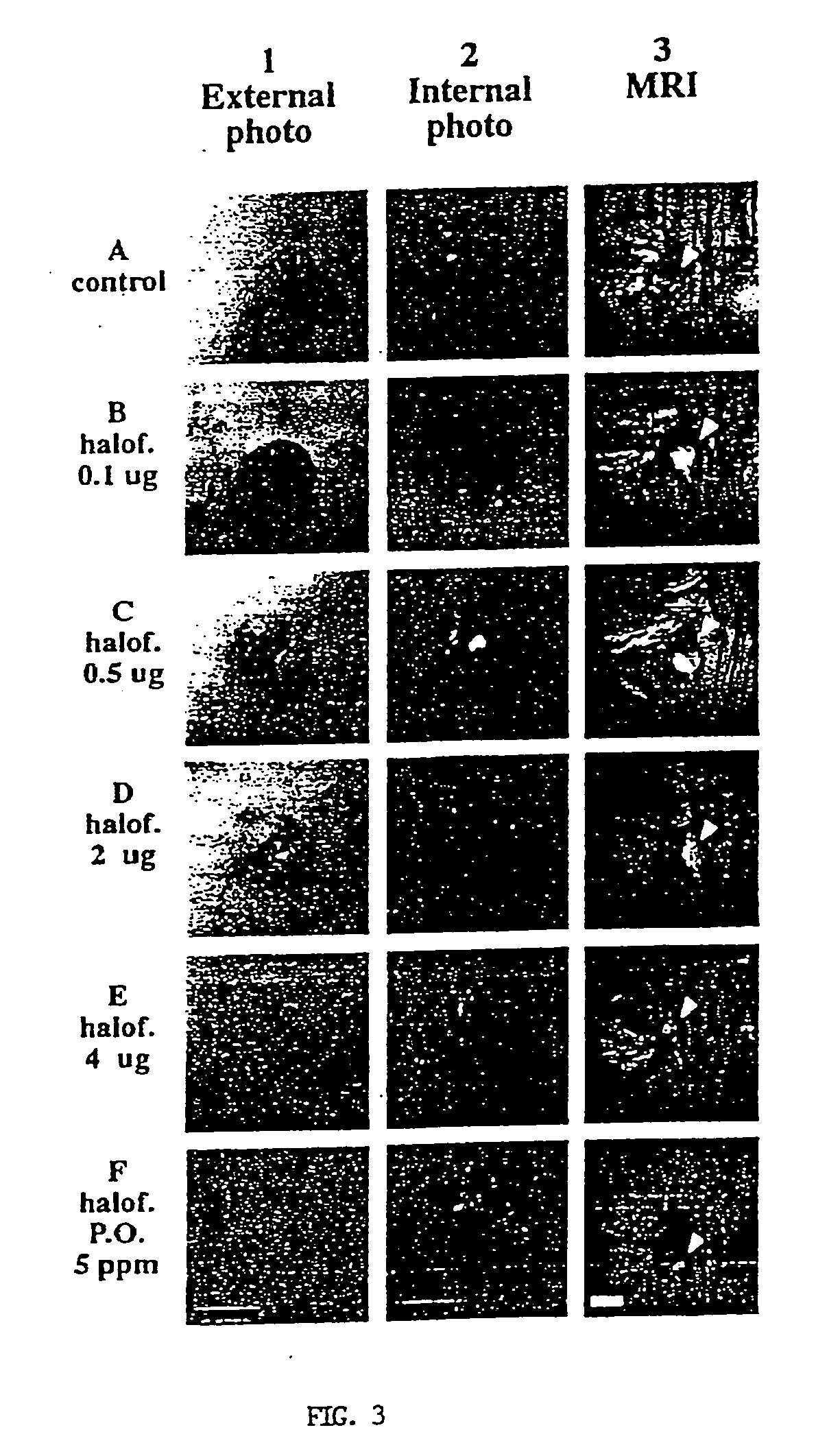Promotion of wound healing
- Summary
- Abstract
- Description
- Claims
- Application Information
AI Technical Summary
Benefits of technology
Problems solved by technology
Method used
Image
Examples
example 1
Effect of Halofuginone on Wound Healing
[0070] The effect of Halofuginone on wound healing was examined by using mice which were first irradiated and then wounded. As shown in FIG. 1, although Halofuginone treatment caused a reduction in the collagen content of the wounded and irradiated skin, the wound still healed.
[0071] The experiment was conducted as follows. First, C3H, defined-flora, pathogen-free female mice of 12-14 weeks of age were anesthetized with 60 mg / kg sodium phenobarbital. The mice were then shaved. One group of mice was then irradiated as follows. First, a flap of skin about 40 mm long and about 20 mm wide was pulled through a slit in the lead cover of an irradiation jig and secured with tape, so that only the flap of skin was exposed. This exposed skin as then irradiated by using a 175 kVp / 20 mA orthovoltage X-ray source, with a 2 mm Cu filter at a dose rate of 1.0 Gy / min. A standard dose of 18 Gy was delivered.
[0072] All of the mice were then wounded by making ...
example 2
Halofuginone Improves Wound Healing in Mice with Tumors
[0077] Tumors from C6 rat glioma cells were prepared and implanted in nude mice. Certain mice received Halofuginone, either orally or through i.p. (intra-peritoneal) administration. The results showed that in mice which received Halofuginone, wound healing was promoted substantially without scar formation. The experimental method was as follows.
[0078] C6 rat glioma cells were cultured in DMEM supplemented with 5% FCS, 50 units / ml penicillin, 50 micrograms / ml streptomycin and 125 micrograms / ml fungizone. Aggregation of cells into small spheroids of about 150 microns was initiated by replating cells from confluent cultures onto agar-coated bacteriological plates. After 4-5 days in culture, the suspension was transferred to a 250 ml spinner flask (Bellco, USA), and the medium was changed every other da for 30-40 days. All culture operations were performed at 37° C. and 5% CO2. Other conditions were as previously reported (Abramov...
example 3
Effect of Halofuginone on Stricture Formation
[0087] Tile effect of Halofuginone in post-trauma stricture formation in rats was studied. Briefly, urethral strictures were induced by catheterization and application of an electrical current to the urethra of rats. The rats were divided into four groups: untreated rats as controls (FIG. 5A); rats treated with Halofuginone but not with coagulation current (FIG. 5B); rats treated with coagulation current alone (FIG. 5C); and rats treated with both Halofuginone and coagulation current (FIG. 5D-5F). Rats which received only coagulation current had clear strictures, while rats treated with both Halofuginone and coagulation current did not have such strictures.
[0088] The experiments were performed as follows. First, urethral catherization was performed on anesthetized rats with a 23 G Quik-Cath (Baxter, Ireland) sheath. A spinal needle was inserted into the sheath, and was used to apply a coagulation current at a level of 10 W to the outer ...
PUM
 Login to View More
Login to View More Abstract
Description
Claims
Application Information
 Login to View More
Login to View More - Generate Ideas
- Intellectual Property
- Life Sciences
- Materials
- Tech Scout
- Unparalleled Data Quality
- Higher Quality Content
- 60% Fewer Hallucinations
Browse by: Latest US Patents, China's latest patents, Technical Efficacy Thesaurus, Application Domain, Technology Topic, Popular Technical Reports.
© 2025 PatSnap. All rights reserved.Legal|Privacy policy|Modern Slavery Act Transparency Statement|Sitemap|About US| Contact US: help@patsnap.com



